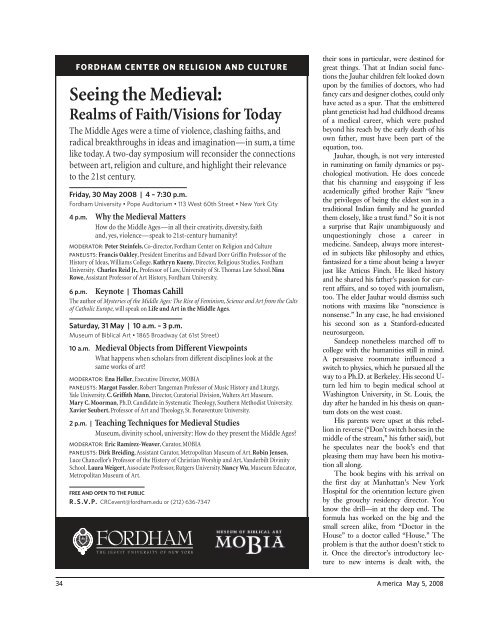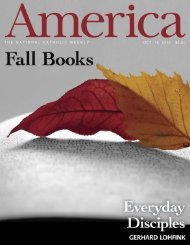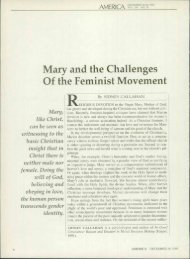Download PDF - America
Download PDF - America
Download PDF - America
Create successful ePaper yourself
Turn your PDF publications into a flip-book with our unique Google optimized e-Paper software.
Seeing the Medieval:Realms of Faith/Visions for TodayThe Middle Ages were a time of violence, clashing faiths, andradical breakthroughs in ideas and imagination—in sum, a timelike today. A two-day symposium will reconsider the connectionsbetween art, religion and culture, and highlight their relevanceto the 21st century.Why the Medieval MattersHow do the Middle Ages—in all their creativity, diversity, faithand, yes, violence—speak to 21st-century humanity? Peter Steinfels, Co-director, Fordham Center on Religion and Culture Francis Oakley, President Emeritus and Edward Dorr Griffin Professor of theHistory of Ideas, Williams College. Kathryn Kueny, Director, Religious Studies, FordhamUniversity. Charles Reid Jr., Professor of Law, University of St. Thomas Law School. NinaRowe, Assistant Professor of Art History, Fordham University.KeynoteThomas CahillThe author of Mysteries of the Middle Ages: The Rise of Feminism, Science and Art from the Cultsof Catholic Europe, will speak on Life and Art in the Middle Ages.Medieval Objects from Different ViewpointsWhat happens when scholars from different disciplines look at thesame works of art? Ena Heller, Executive Director, MOBIA Margot Fassler, Robert Tangeman Professor of Music History and Liturgy,Yale University. C. Griffith Mann, Director, Curatorial Division, Walters Art Museum.Mary C. Moorman, Ph.D. Candidate in Systematic Theology, Southern Methodist University.Xavier Seubert, Professor of Art and Theology, St. Bonaventure University.Teaching Techniques for Medieval StudiesMuseum, divinity school, university: How do they present the Middle Ages? Eric Ramírez-Weaver, Curator, MOBIA Dirk Breiding, Assistant Curator, Metropolitan Museum of Art. Robin Jensen,Luce Chancellor’s Professor of the History of Christian Worship and Art,Vanderbilt DivinitySchool. Laura Weigert, Associate Professor, Rutgers University. Nancy Wu, Museum Educator,Metropolitan Museum of Art. their sons in particular, were destined forgreat things. That at Indian social functionsthe Jauhar children felt looked downupon by the families of doctors, who hadfancy cars and designer clothes, could onlyhave acted as a spur. That the embitteredplant geneticist had had childhood dreamsof a medical career, which were pushedbeyond his reach by the early death of hisown father, must have been part of theequation, too.Jauhar, though, is not very interestedin ruminating on family dynamics or psychologicalmotivation. He does concedethat his charming and easygoing if lessacademically gifted brother Rajiv “knewthe privileges of being the eldest son in atraditional Indian family and he guardedthem closely, like a trust fund.” So it is nota surprise that Rajiv unambiguously andunquestioningly chose a career inmedicine. Sandeep, always more interestedin subjects like philosophy and ethics,fantasized for a time about being a lawyerjust like Atticus Finch. He liked historyand he shared his father’s passion for currentaffairs, and so toyed with journalism,too. The elder Jauhar would dismiss suchnotions with maxims like “nonscience isnonsense.” In any case, he had envisionedhis second son as a Stanford-educatedneurosurgeon.Sandeep nonetheless marched off tocollege with the humanities still in mind.A persuasive roommate influenced aswitch to physics, which he pursued all theway to a Ph.D. at Berkeley. His second U-turn led him to begin medical school atWashington University, in St. Louis, theday after he handed in his thesis on quantumdots on the west coast.His parents were upset at this rebellionin reverse (“Don’t switch horses in themiddle of the stream,” his father said), buthe speculates near the book’s end thatpleasing them may have been his motivationall along.The book begins with his arrival onthe first day at Manhattan’s New YorkHospital for the orientation lecture givenby the grouchy residency director. Youknow the drill—in at the deep end. Theformula has worked on the big and thesmall screen alike, from “Doctor in theHouse” to a doctor called “House.” Theproblem is that the author doesn’t stick toit. Once the director’s introductory lectureto new interns is dealt with, the34 <strong>America</strong> May 5, 2008









